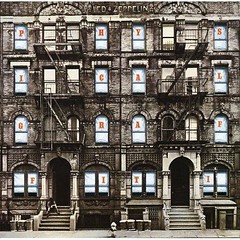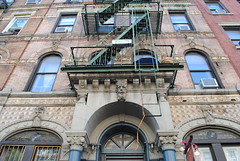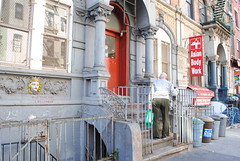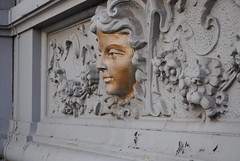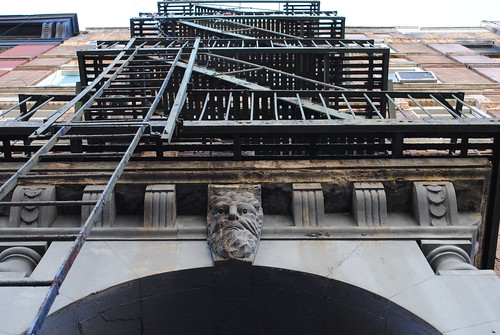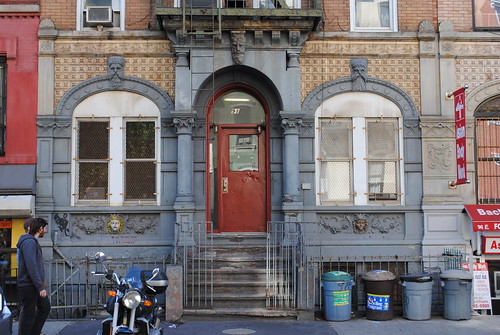 Carl Guadalupe The front steps of 98 St. Marks Place today (above) and as it appeared on the cover of Led Zeppelin’s 1975 album “Physical Graffiti.”
Carl Guadalupe The front steps of 98 St. Marks Place today (above) and as it appeared on the cover of Led Zeppelin’s 1975 album “Physical Graffiti.”The buildings’ stony expressions look out over this last leg of St. Marks Place going east, between First Avenue and Avenue A. At first glance these two buildings look like standard East Village stock, but, eyes wide-open, the facades of 96 and 98 St. Marks Place have witnessed musical history taking place on their very stoops.
They are the iconic buildings featured on the cover of Led Zeppelin’s 1975 album Physical Graffiti, and also in the 1981 Rolling Stones music video, “Waiting on a Friend.”
Bobby Pinn, the creator and host of Rock Junket walking tours, “In the 70’s, Led Zeppelin were big fans of New York City. They partied here a lot and they played the Garden quite a bit, so they really had a close tie to New York. The cover was designed by Peter Corriston, a graphic design artist from New York. Peter said that he was looking for a building with a lot of character, which this building has with all the kings’ faces and it has that tenement-style feel with the fire escapes. He wanted a building that had symmetry and a lot of windows.”
Mr. Pinn went on to talk about the set of choice for the Rolling Stones. “Peter Corriston also did the design for ‘Tattoo You’ and ‘Some Girls’ so he’s tied in with the artwork for all these covers, but I think it’s unusual and remarkable at the same time that two of England’s biggest bands would both be associated with one building on St. Marks Place.”
Emile Bellucci, superintendent of 114 St. Marks Place, remembers seeing Mick Jagger the day “Waiting on a Friend” was shot. “Me and my friend, we were going somewhere and we just happened to wonder what they were doing and found out they were shooting a video. I looked and there he was sitting on that stoop. I could’ve gotten his autograph but didn’t think about that. I was a Beatles fan at the time.”
Most of the buildings on the block with the exception of 96 and 98 have received face lifts. There are now two businesses on the basement level of 96, one of which is a vintage clothing shop called Physical Graffiti, but besides some new paint and gates, Mr. Pinn said the structures have stayed the same.
However, James Bedford, superintendent of 110 St. Marks Place, has noticed other changes. “You got a lot of young people staying in the building now. Not a lot of old people.” And naturally, both Mr. Bedford and Mr. Bellucci note the differences in rent.
The buildings at 96 and 98 St. Marks Place are neighborhood icons and represent one of the most important aspects of the East Village – its musical history. Jimmy Webb, the buyer for vintage clothes stores Trash and Vaudeville, and himself an East Village rock ‘n’ roll icon, said he gets asked all the time about the location of the “Physical Graffiti” buildings. Strolling down memory lane and referring to the Rolling Stones music video, he said, “What an appropriate place for whatever that song is about. That was the perfect corner to be waiting for a friend.”



